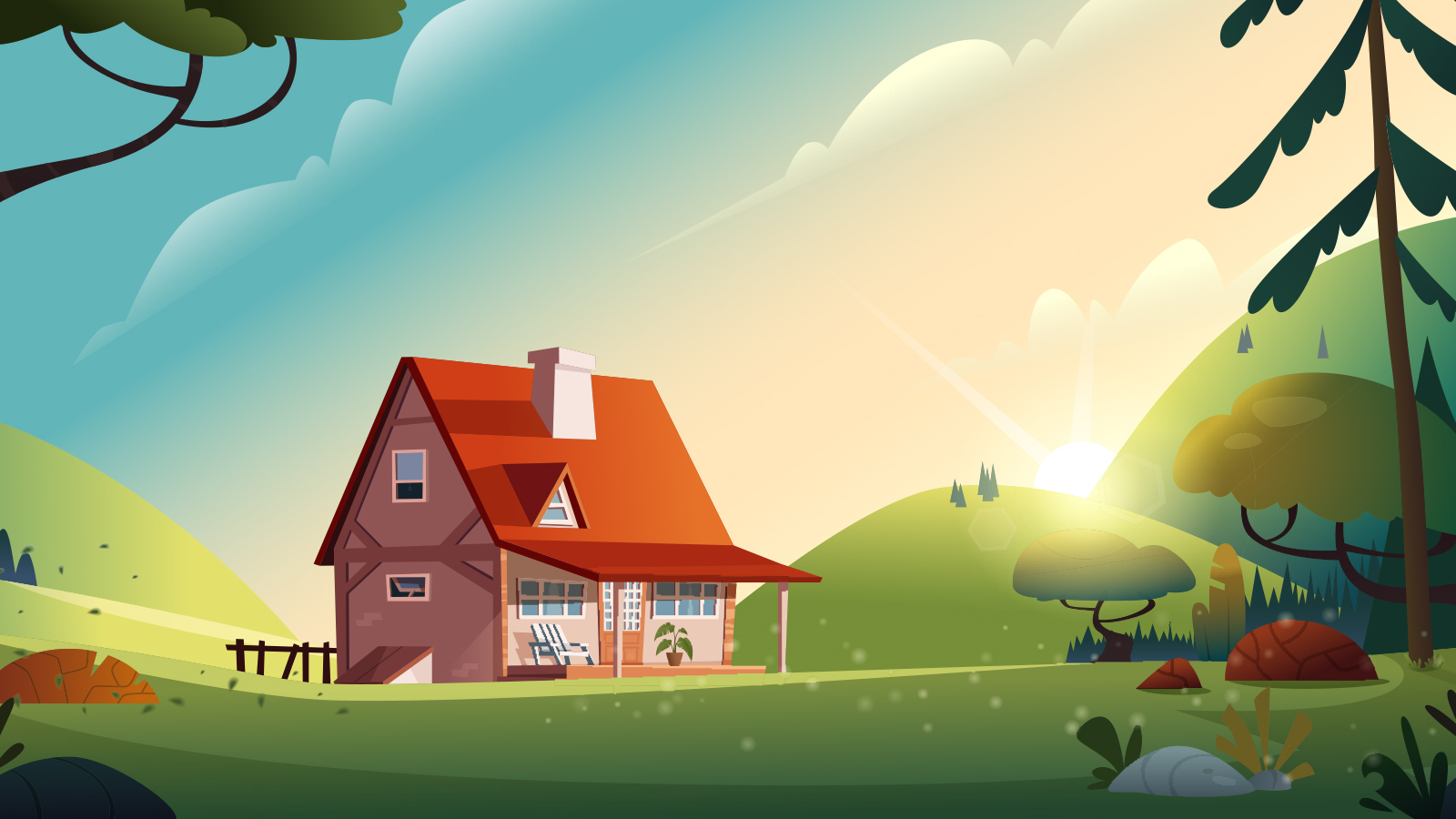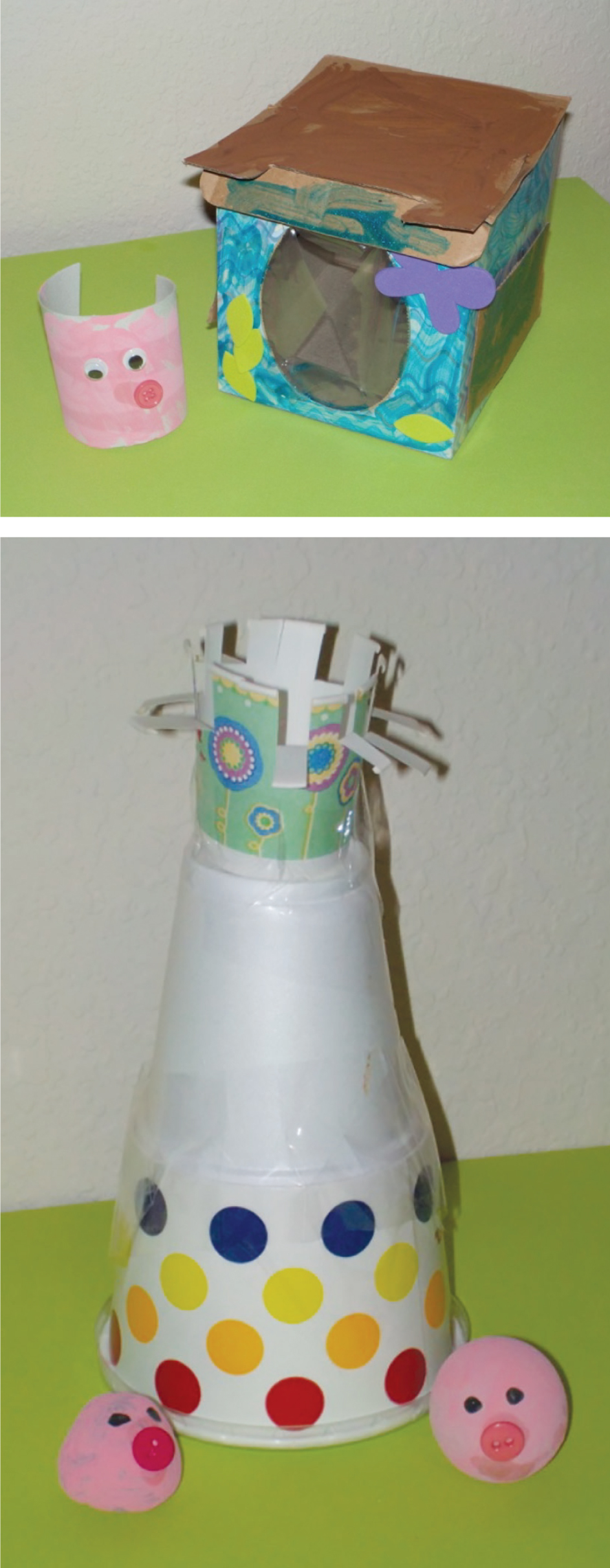A Home for Three Little Pigs
Science and Children—October 2019 (Volume 57, Issue 3)
By Barbara A. Bradley, Kelli Thomas, and A. Allen Bradley Jr.

Preschool students learn about engineering through designing and testing homes.
The “big bad wolf” chased the squealing children around the playground as they looked for a place to hide. Because Mr. Lòpez and Ms. Kim had introduced the work of engineers and the engineering design process into their unit on The Three Little Pigs, they knew their preschool students would choose a structure that could withstand any huffing and puffing from the wolf. They also knew that their students could do the work of engineers because it aligns with children’s desire to help people or, in this case, three little pigs, and it taps into their natural curiosity and problem-solving abilities.
Day 1: Meeting the Three Little Pigs
Mr. Lòpez began the unit by reading The Three Little Pigs (Jewitt 2012). Afterward, he told students that they would be designing and building a new home for the pigs. The engineering design process begins with asking questions. Mr. Lòpez started by asking students to think about what the pigs might need. Students decided the pigs needed three bedrooms, a living room with a big screen TV, a big kitchen because pigs like to eat, and a playroom with a trampoline because pigs like to jump. These became the constraints or “must haves” for their house design.
Engineers learn about problems from failures (Petroski 2018). So, to help the students identify the problem to solve, Mr. Lòpez asked, “Why did the first and second pigs’ homes fall down but not the third pig’s home?” Students knew that straw and sticks are easy to break but bricks are strong. He then asked “Why would someone build a home with straw or sticks instead of bricks?” They realized that straw and sticks are easy to find, while bricks take time to make. Mr. Lòpez summarized the problem: a house built too quickly out of weak materials might fall down. He then asked how they might solve that problem when building their houses. Students said that they would take their time and build with strong materials. Agreeing, Mr. Lòpez told students that they were thinking like engineers. To solve the problem, they would follow the engineering design process. The students would research possible materials they could use to build their house, imagine the structure they wanted by drawing a plan or blueprint, create a model house and test it, and then create their house to share at an open house.
On day 1, by Asking Questions and Defining Problems, the students developed constraints for the house the rooms needed and identified a problem to be solved: the strength of building materials. In coming days, they would be Developing and Using Models by creating plans and making prototypes or models from different materials for testing, and Analyzing and Interpreting Data from their tests to see what works and finalize their house design.

It was now time to imagine their dream house for the little pigs and draw it out on paper. The houses needed space for the bedrooms, living room, kitchen, and playroom, but could be any size or shape. Many students sketched traditional houses with one or two stories. Some drew tall houses like a high-rise with multiple stories. See Figure 2 for an example a student drawing. Mr. Lòpez told the class that just like engineers, they had imagined many possible designs that solved the problem. Tomorrow, they would explore some alternatives in more detail.

Days 3–4: Creating a Prototype and Testing
Mr. Lòpez asked his group to first build a prototype or model house with drinking straws. Some students built model houses one straw high, and other students taped together additional straws to make to the houses two and three straws high. Mr. Lòpez then showed students the ground for their houses, a mound of gelatin made at home the previous day. He asked them to predict if their house would remain standing or fall down. Then, the students carefully placed their straw houses into the gelatin. All the houses remained standing! However, the students realized that the tallest houses that were three straws high were bent over; they had not fallen down, but they were not as straight and stable as short houses that were one straw high. Mr. Lòpez then asked students to predict what might happen if he wiggled the plate back and forth to simulate an earthquake. As he gently wiggled the plate of gelatin, the tallest structure began to sway and fall over. The students were curious and wondered if more tape might help the structures. After discussing what happened and why, they concluded gelatin was too soft to build tall houses. However, they learned that shorter houses worked better on softer ground, especially when the ground shook. Introducing the Building a House chart to record their findings (Table 1, p. 43), students indicated that “no” they shouldn’t build a house on soft ground like gelatin because it’s “too wiggly” and students suggested they “find hard dirt ground.”
| Building a strong house. | |||||||||||||||
|---|---|---|---|---|---|---|---|---|---|---|---|---|---|---|---|
|
|||||||||||||||
Days 5–8: Creating and Testing Houses
Students were excited to share their findings with their peers. They learned that they needed to build short houses, preferably on hard ground so they wouldn’t topple over. They also needed to use strong, heavy materials to withstand heavy wind and blizzards. Mr. Lòpez then read the first half of Look at That Building! A First Book of Structures (Ritchie 2011) to reinforce important ideas such as drawing a blueprint, building on a strong foundation, and choosing materials wisely to construct frames and walls (see Resources for books about construction). Students revised their blueprint and chose sturdy items from recycled materials to construct their houses.
Day 6, Mr. Lòpez read How a House Is Built (Gibbons 1990) and day 7, he read Iggy Peck Architect (Beaty 2007). After discussing each book, students followed their blueprints as best they could to build their houses with the recycled materials. In addition to building houses, a few students decided to create other buildings for the pigs. For example, one student created a recording studio. Another student built a grocery store. When their structure was complete, each student tested his/her house with a teacher to determine if it could withstand an earthquake, strong winds, or a blizzard. While most houses withstood the forces, when a design failed, it created an opportunity for the student and teacher to reflect on the design and determine how to fix it. For example, the student who built a recording studio for the pigs found that the structure moved in strong winds. He decided to put rocks in his structure to make it heavier After retesting his improved design, he learned the rocks worked and they became “chairs” for the pigs. Based on the outcome of the tests, some students improved their houses, most often by reinforcing their structures with additional and/or stronger materials e.g., cardboard or tape and glue. As students tested their houses, Mr. Lòpez and Ms. Kim used a summative assessment and rubric to evaluate individual student learning related to key aspects of the process (see NSTA Connection). They asked questions that focused on the original problem (e.g., two pigs built quickly and with poor materials) and how weather conditions influenced their prototypes and the houses they created from recycled materials. On day 8, students painted and decorated their house. They also made little pigs by painting materials such as rocks and toilet paper tubes cut in half, and gluing on googly eyes, button noses, and pieces of pipe cleaner for tails (Figure 4, p. 45).

Day 9— 10: Hosting an Open House
Students learned about the engineering design process as they thought about the structural failures experienced by the first two pigs and success of the third pig. Based on their suggestions, students reviewed what they had learned from their investigations so they could share that information with visitors coming to an open house (Table 2). The students practiced what they would tell visitors about their investigations and homes before the open house.
| Reviewing the engineering design process. | ||||||||||||||||
|---|---|---|---|---|---|---|---|---|---|---|---|---|---|---|---|---|
|

The Open House was a success as parents, the principal, staff, and other classes came to see homes. Students told them about their investigations and answered questions. Visitors appreciated what students had learned and the home they built, and wrote kind notes on the students’ final checklist.
Conclusion
Students enjoyed helping the three little pigs as they asked questions; identified problems; imagined solutions; planned, created and tested model houses; and built, tested and improved their design to build strong, safe houses (Pantoya, Aguire-Muñoz, and Hunt 2015). The Three Little Pigs effectively introduced young students to the engineering design process, and like engineers, they helped solve a problem.
Connecting to the Next Generation Science Standards (NGSS Lead States 2013)
Standard
K-2-ETS1 Engineering Design
www.nextgenscience.org/dci-arrangement/k-2-ets1-engineering-design
- The chart below makes one set of connections between the instruction outlined in this article and the <i>NGSS</i>. Other valid connections are likely; however, space restrictions prevent us from listing all possibilities.
- The materials, lessons, and activities outlined in the article are just one step toward reaching the performance expectation listed below.
Performance Expectation
K-2-ETS1-1. Ask questions, make observations, and gather information about a situation people want to change to define a simple problem that can be solved through the development of a new or improved object or tool.


